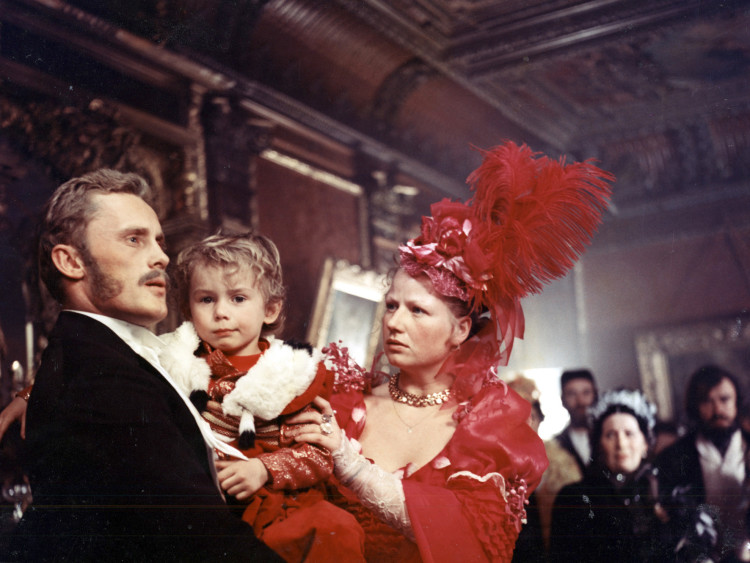From Mansarda to Alex

Scheibler’s Palace, which has been the seat of the Film Museum for the past three decades, is one of the most often photographed buildings in Lodz. Nearly 30 feature films, TV series and theatre performances (excluding film etudes by students of the neighbouring Lodz Film School) have been created here.
Filmmakers first appeared in Scheibler’s Palace in 1963 when the building housed the Music School. Konrad Nałęcki, even before directing Four Tank-Men and a Dog (Czterej pancerni), shot here his Mansard (Mansarda) which featured such excellent actors as Leszek Herdegen, Tadeusz Łomnicki, Ignacy Gogolewski, Aleksandra Śląska and Andrzej Szczepkowski. In the film the Scheiblers’ ballroom hosts a party organised by a painter, Aleksander Gierymski, for Warsaw artists and art connoisseurs. The score was written by Wojciech Kilar.
A few years later flags with swastikas and a portrait of Hilter were hung in the palace. This time the ballroom served as a setting for awarding Hans Kloss (Stanislaw Mikulski) the Iron Cross – a high rank military distinction which also gave the name for the episode title. Two episodes earlier the same interior “played” Cafe Rose – an exclusive bordello in Istanbul. Even Mel Brooks would be proud of such juxtaposition. And his film The Producers, about two cheaters trying to go bankrupt by producing a musical about Hitler, opened in theatres in 1968 that is in the same year when Stakes Larger Than Life (Stawka większa niż życie) appeared on TV.
Berlin, Istanbul… Filmmakers were eager to re-locate the palace to various places across Europe. In Pavoncello (1967) by Andrzej Żuławski the palace turned into a suburban villa in Rome; in Rosary of Grenades (Różaniec z granatów, 1970) by Jan Rutkiewicz it was the headquarters of the Francoist army; in The Doll (Lalka, 1977) by Ryszard Bera it was a room in the Hotel du Louvre in Paris where Wokulski (Jerzy Kamas) was staying. In turn, in Between the Cup and the Lip (Między ustami a brzegiem pucharu, 1987) by Zbigniew Kuźmiński the Scheiblers’ Palace “played” two apartments in Berlin and in Return of the Wolf (Powrót wilczycy, 1990) by Marek Piestrak it was a near-Cracow mansion of the Ziębalski family (Marzena Trybała, Leon Niemczyk).
Let us return to Lodz. – People must know. Muller has money and palaces – declares a German factory owner (Franciszek Pieczka) in The Promised Land (Ziemia obiecana, 1974), a masterpiece directed by Andrzej Wajda based on the novel by Władysław Reymont. Karol Borowiecki, in the unforgettable portrayal by Daniel Olbrychski, knows about it and goes to Muller to ask for a loan. The millionaire shows the astounded Pole around his residence. The film shows the famous Venetian mosaic by Salvati in the fireplace extension, a Neo-Renaissance chest of drawers and impressive paintings on the ceiling. – Did you furnish it yourself, Mr Muller? – asks Borowiecki. And the answer is: I paid for it myself .
The meeting between the living and the imagined characters of How Far, How Near (1971) by Tadeusz Konwicki is equally outstanding. The director along with the cinematographer, Mieczysław Jahoda, used a natural layout of the rooms, which enabled them to shot a long scene. Andrzej Łapicki watches a dance procession moving through the private office, the dining room and the ballroom. And, by the locker room, he meets a friend who committed suicide (Gustaw Holoubek); in the Mauritian room he comes across a friend who likes to party (Zdzisław Maklakiewicz) and he encounters a beautiful strange girl (Anna Dymna) by the cupboard.
When recalling film roles played by Scheibler’s Palace one cannot omit Vabank (1981) by Juliusz Machulski. The interior of the palace does not appear in the director’s debut itself but the true gem of the Museum’s collection, the photoplasticon (which at that time was located in the Poznański Palace, i.e. in the Museum of the City of Lodz), does. – Who are they, Kwinto? – asks Duńczyk (Witold Pyrkosz) watching the over-excited Maks (Jacek Chmielnik) and Nuta (Krzysztof Kiersznowski) sitting next to him. – Pay no attention to them – is the answer of the famous safe-cracker (Jan Machulski).
Also the most recent big production shot in the Museum is of a criminal nature. This production was Inspector Alex (Komisarz Alex). In the episode entitled Three seconds (Trzy sekundy, 2012) a beautiful girl (Karolina Chapko) discovers – as could be expected – a dead body.
